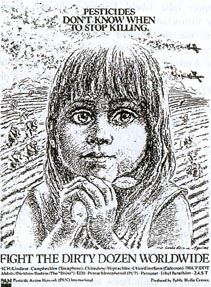EXPORT OF HAZARDOUS WASTE
In Bangladesh exists neither knowledge on hazardous waste or laboratory facilities to analyse chemicals or substances that pose threat to human life and nature
Contaminated fertiliser/agrochemical was used in Bangladesh. but in the case of Bangladesh it is most possibly that hazardous waste was additionally mixed for the export to Bangladesh. In 1992 Stoller Chemical Company in association with Gaston Copper Recycling Co of USA exported fertiliser to Bangladesh which contained 50 percent extremely toxic heavy metals-, several thousand times higher than the allowable level. This became public through Greenpeace. Bangladesh does not have any controlling mechanism and analytical facilities to inhibit such imports. According to a report by the US Congrss General Accounting Office, 30 percent of all pesticides exported from the United States were unregistered - that is, not approved by the Federal Environmental Protection Agency - for use in the United States. The chief exporters of pesticides are companies based in Germany (25%), USA (20%), United Kingdom (15%), Switzerland (15%), Japan (5%) and Italy (3%). Many pesticides that are forbidden in these countries due to hazardous consequences are exported to developing countries. After the introduction of High Yield varieties of crop, development aid from the First World created many fertiliser factories within the developing countries. Fertiliser production creates many hazardous products and safe disposal is still not possible. A solid waste is produced in Vetrocoke (potassium carbonate) processes for eliminating carbon dioxide in the manufacture of ammonia. The sludge contain 20 per cent arsentrioxide As2 03 (Development Transfer of Technology Series No. 13, Fertiliser Manual, UN, NY, 1980). Bangladesh or other developing countries do not have the facilities to dispose of such toxic waste.
It may be recalled that under the Asian Development Bank credit (1991-92) heavy metal contaminated fertilisers were imported into Bangladesh. About 6300 metric tonnes of fertilisers were imported from the USA which contained toxic heavy metals. The absence of controlling know-how and corruption open an easy market for the scrupulous businessmen. No body knows the chemical composition of the imports that were freely distributed into this sub-continent. Fertilisers used in India such as Super-phosphate contained 187.8 mg/100 gm arsenic (Murti,1987) an extremely high level and in Bangladesh about 2.26 metric tons of chemical fertilisers was used in 1990-91, but analysis on arsenic content or other hazards was not carried out. But the farmers always reported on the impurity of fertilisers. On 1st January 1995 3,000 tonnes of Super-phosphate were imported from India which contained about 30% impurity of unknown composition. Farmers protested to the police and Government but, as usual, nothing happened (Chinta, 1995).
About 40% of the fertiliser in Bangladesh is washed into the riverine and ground-water systems (Safiullah and Mafizuddin, 1988). A recent study shows that a high concentration of ammonia (NH4) and nitrate (N03) occur in the samples from shallow and deep tube wells (Hossain, 1997).Agriculture is directly supported by the chemical fertilisers, pesticides for which the World Bank has granted loans for several projects (the total credit for this sector from 1973 to February 1996 is US dollars 166 million). The growth rates of total rice production (the hero of our green revolution - HYV Boro) seems to have gone down and acreage during the last four years show a distinct downward move compared to the preceding period and to the decade's average trend (Bayes, 1995).
The use of chemical fertilisers to grow the hybrid has brought severe damage to the soil. According to a study by BARC (Bangladesh Agricultural Research Centre) 70% of Bangladesh's total arable land has reached the critical level or has gone even below. Although World Bank views that the damage has been caused by "incorrect fertiliser application" but the IRRI (International Rice Research Institute, Manila) itself now recognises that in order to maintain the same level of production more and more chemical fertiliser has to be applied which again degrades the soil and the environment even more. Despite a government ban on sales of toxic insecticides the chemical substances were being sold to farmers who were using those in agriculture, especially in production of vegetables without being aware of their harmful effect.
Toxic chemicals
It is a good thing that the various environmentalist groups are making their voice heard. Bangladesh being a poverty stricken land of 130 million people, environment is a much-neglected issue. The repercussions of environmental pollution though dangerous are not immediate. Added to this fact the vast majority of people in the country are illiterate. Even among the educated people few are aware about the harmful effects of pollution. Unfortunately Bangladesh may become one of the worst victims of environmental degradation. The potential rise in sea level will mean great catastrophe for the country.
The government after years of neglect has taken the matter more seriously of late. The banning of polythene and two-stroke-engine three wheelers were both steps in the right direction. In both the cases the public were skeptic at the initial stages. However soon the people welcomed the decisions and co-operated with the authorities. This goes to show that if there is adequate motivation and education the people will follow and appreciate rules. After all, the environment concerns the future of the next generation and nobody is willing to compromise the future of their children.
Experts believe that though these insecticides help the farmers get rid of pests they can cause irreversible damage to the land as well as people in the long run. In the developed countries too they are keen on developing alternatives to chemical repellants. Initial research is very promising. According to all indications the Bangladeshi farmers must minimise the use of chemical insecticides or pesticides. And completely shun the strongly toxic chemicals called 'Dirty Dozen'. For this they need total support from the concerned authorities.(Editorial, The Independent, December 9, 2003)
1. Agrochemical Imported Pollutant.
2. Bangladesh buys for 271 million US dollar in 2001 - Toxic Waste
3. Arsenic and Uranium in Fertilizer
